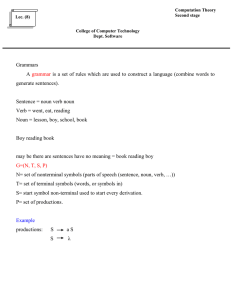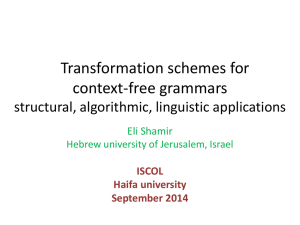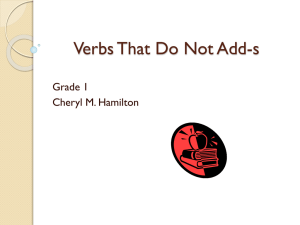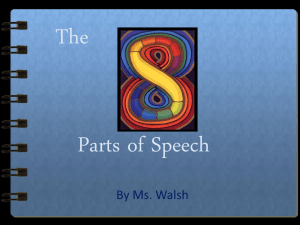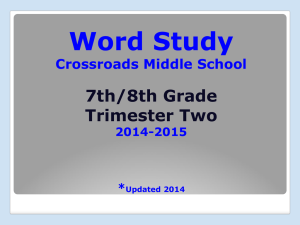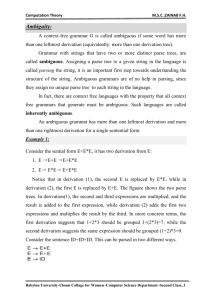Document
advertisement
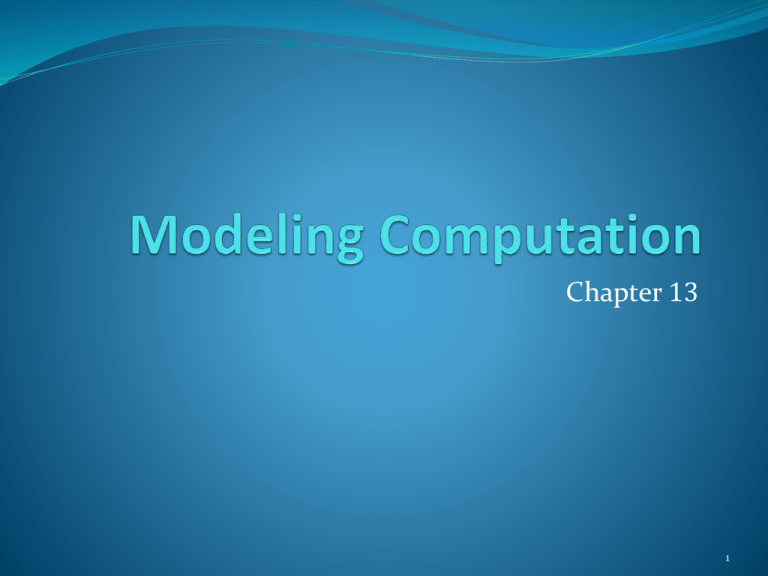
Chapter 13
1
Chapter Summary
Languages and Grammars
Finite-State Machines with Output
Finite-State Machines with No Output
Language Recognition
Turing Machines
2
Section 13.1
3
Section Summary
Phrase-Structure Grammars
Types of Phrase-Structure Grammars
Derivation Trees
Backus-Naur Form
4
Introduction
Syntax (form of a sentence) vs. semantics (meaning
of a sentence)
The sentence the frog writes neatly is a valid
sentence according to the rules of English grammar.
That is, it is syntactically correct, even though it’s
nonsensical (unless we are talking about a fantasy
world).
The sequence of words swims quickly mathematics
is not a valid sentence according to the rules of English
grammar.
5
Grammars
The rules that specify the syntactically correct
sentences of a natural language such as English are
complex.
Instead of studying natural languages, we can define
formal languages that have well-defined rules of
syntax.
These rules of syntax are important both in linguistics
(the study of natural languages) and in the study of
programming languages.
6
An Example Grammar
1.
2.
3.
4.
5.
6.
7.
8.
9.
10.
11.
12.
13.
14.
15.
a sentence is made up of a noun phrase followed by a verb phrase;
a noun phrase is made up of an article followed by an adjective followed by a noun, or
a noun phrase is made up of an article followed by a noun;
a verb phrase is made up of a verb followed by an adverb, or
a verb phrase is made up of a verb;
an article is a, or
an article is the;
an adjective is large, or
an adjective is hungry;
We use these rules to form valid sentences by making
a noun is rabbit, or
of replacements until no more rules can be used.
a noun is mathematician;
a verb is eats, or
a verb is hops;
an adverb is quickly, or
an adverb is wildly.
An example sequence of replacements:
noun phrase verb phrase
article adjective noun verb phrase
article adjective noun verb adverb
the adjective noun verb adverb
the large noun verb adverb
the large rabbit verb adverb
the large rabbit hops adverb
the large rabbit hops quickly
a series
Some additional valid sentences are:
a hungry mathematician eats wildly,
a large mathematician hops,
the rabbit eats quickly, etc.
But note that the following is not valid:
the quickly eats mathematician
7
Phrase-Structure Grammars
A vocabulary (or alphabet) V is a finite, nonempty set of elements called
symbols.
A word (or sentence) over V is a string of finite length of elements of V.
The empty string or null string, denoted by λ, is the string containing no
symbols.
The set of all words over V is denoted by V*. A language over V is a subset
of V*.
The elements of V that can not be replaced by other symbols are called
terminals, e.g., a, the, and rabbit in the example grammar.
Those that can be replaced by other symbols are called nonterminals, e.g.,
sentence, noun phrase, etc.
The rules that specify when we can replace a string V* with another string
are called productions of the grammar. We denote by z0 → z1 the
production that specifies that z0 can be replaced by z1 within a string.
8
Phrase-Structure Grammars (cont.)
A phrase-structure grammar G =(V, T, S, P) consists
of a vocabulary V, a subset T of V consisting of
terminal symbols, a start symbol S from V, and a finite
set of productions P.
The set N = V −T is the set of nonterminal symbols.
Every production in P must contain at least one
nonterminal on its left side.
***Example (Grammar 1): Let G =(V, T, S, P), where
V = {a, b, A, B, S}, T = {a,b}, S is the start symbol, and
P = {S →Aba, A →BB, B →ab, AB →b}.
9
Derivations
Let G =(V, T, S, P) be a phrase-structure grammar. Let w0 = lz0r (that is
the concatenation of l, z0, and r) and w1 = lz1r be strings over V. If
z0 → z1 is a production of G, we say that w1 is directly derivable from w0
and write w0 ⇒w1.
If w0,w1, ...,wn are strings over V such that w0 ⇒w1, w1 ⇒w2, …,
∗
wn-1 ⇒ wn, then we say that wn is derivable from w0 and write w0 ⇒ wn.
The sequence of steps used to obtain wn from w0 is called a derivation.
Example (Grammar 1): Aaba is directly derivable from ABa because
B →ab is a production and abababa is derivable from ABa because
ABa ⇒ Aaba ⇒ BBaba ⇒ Bababa ⇒ abababa using the productions
B →ab, A →BB, and B →ab in both of the last two steps of the derivation.
10
Language Generation
Let G =(V, T, S, P) be a phrase-structure grammar. The
language generated by G, denoted by L(G), is the set of all
strings or terminals that are derivable from the starting
state S.
∗
In other words, L(G) = {w ∈ T* | S ⇒ w}.
Let G be the grammar with the vocabulary V = {S, A, a, b}, a
set of terminals T = {a, b}, starting symbol S, and
productions P = {S → aA, S → b, A → aa}.
L(G) = {b, aaa}, because we can begin a derivation with
S → aA or with S → b, and from aA we can derive aaa
using A → aa. There are no other possible derivations.
11
Types of Phrase Structure
Grammars
Avram Noam Chomsky
(Born 1928)
Phrase-structure grammars are classified by the types of
allowable productions.
Type 2 grammars are called context-free grammars. A
language generated by a context-free grammar is called a
context-free language.
Type 3 grammars are called context-sensitive grammars (or
a regular grammar). A language generated by a contextsensitive grammar is called a context-sensitive language (or
a regular language).
12
Derivation Trees
We can represent a derivation in the language generated by a context-
free grammar by an ordered rooted tree, called a derivation, or parse
tree.
The root of the tree represents the start symbol.
The internal vertices represent the nonterminal symbols that arise in
the derivation.
The leaves represent the terminal symbols that arise.
If the production A →w, where w is a word, arises in the derivation,
the vertex that represents A has as children vertices that represent each
symbol in w, in order from left to right.
A derivation tree for the derivation of the hungry rabbit eats quickly,
given the grammar described earlier.
13
Backus-Naur Form
John Backus
(1924-2007)
Peter Naur
(Born 1928)
Backus-Naur form (BNF) is sometimes used to specify a
type 2 grammar. It is often used to specify the syntactic
rules of computer languages.
The productions of a type 2 grammar have a single
nonterminal symbol on their left-hand side.
All the productions with the same nonterminal symbol on
the left-hand side are combined into one statement using
the symbol ::= instead of →. Additionally,, all nonterminal
symbols are enclosed in brackets (⟨⟩), and the right-hand
side of productions are spearated by bars.
For example, the productions A →Aa, A →a, and A →AB are
written as ⟨A⟩ ::= ⟨A⟩a | a | ⟨A⟩ ⟨B⟩.
14
BNF and ALGOL 60
In the programming language ALGOL 60 an identifier
consists of a string of alphanumeric characters and must
begin with a letter.
The BNF description of allowable identifiers is:
⟨identifier⟩ ::=⟨letter⟩ | ⟨identifier⟩⟨letter⟩ | ⟨identifier⟩⟨digit⟩
⟨letter ⟩ ::= a | b | ⋯ | y | z
⟨digit⟩ ::= 0 | 1 | ⋯ | 8 | 9
x99a is a valid identifier since the first rule can be used to
replace ⟨identifier⟩ by ⟨identifier⟩⟨letter⟩ , the second rule
to obtain ⟨identifier⟩ a, the first rule twice to obtain
⟨identifier⟩⟨digit⟩⟨digit⟩ a, the third rule twice to obtain
⟨identifier⟩99a, the first rule to obtain ⟨letter⟩99a, and
finally the second rule to obtain x99a.
15
